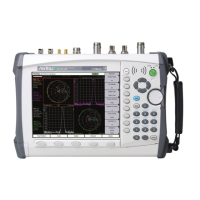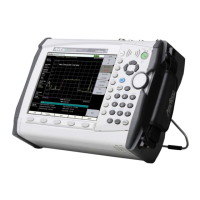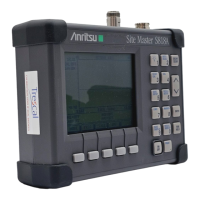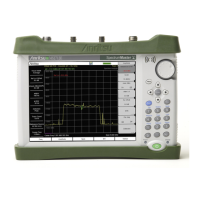2-12 VNA Master Connectors Quick Start Guide
2-26 PN: 10580-00305 Rev. L MS20xxC UG
Port 1 (50 ohm)
This Type-N connector (see Figure 2-13, item “6” on page 2-20) provides the input/output
50 ohm interface for transmission and reflection measurements of the Vector Network
Analyzer at Port 1. Maximum input is +23 dBm at ±50 VDC. Bias Tee output is also
available from this port (with Option 10). The Port 1 green LED (see Figure 2-13, item “17” on
page 2-20) indicates, when lit, that the port is transmitting power.
To prevent damage to your instrument, do not use pliers or a plain wrench to tighten the
Type-N connector. Do not overly tighten the connector. The recommended torque is 12 lbf·in
to 15 lbf·in (1.36 N·m to 1.70 N·m).
Port 2 (50 ohm)
This Type-N connector (see Figure 2-13, item “9” on page 2-20) provides the input/output
50 ohm interface for transmission and reflection measurements of the Vector Network
Analyzer at Port 2. Maximum input is +23 dBm at ±50 VDC. Bias Tee output is also
available from this port (with Option 10). The Port 2 green LED (see Figure 2-13, item “10” on
page 2-20) indicates, when lit, that the port is transmitting power.
To prevent damage to your instrument, do not use pliers or a plain wrench to tighten the
Type-N connector. Do not overly tighten the connector. The recommended torque is 12 lbf·in
to 15 lbf·in (1.36 N·m to 1.70 N·m).
Type K Connectors (Option 11) for VNA Ports
To prevent damage to your instrument, do not use pliers or a plain wrench to tighten the
Type-K connector. Do not over tighten the connector. The recommended torque is 8 lbf·in
(0.9 N·m or 90 N·cm).
Bias Input Port 1
The BNC female connector (see Figure 2-13, item “7” on page 2-20) is used for external bias
tee input that will be routed to Port 1 of the VNA Master. Maximum input is ±50 VDC,
500 mA.
Bias Input Port 2
The BNC female connector (see Figure 2-13, item “8” on page 2-20) is used for external bias
tee input that will be routed to Port 2 of the VNA Master. Maximum input is ±50 VDC,
500 mA.
Bias Status LED
This LED (see Figure 2-13, item “16” on page 2-20) illuminates green when Internal or
External Bias is selected. When using the internal supply, it illuminates red for any overload
condition (current or voltage).
Headset Jack
Instrument models that include a spectrum analyzer will output demodulated audio to this
3.5 mm 2-wire jack, which also accepts most 3-wire headsets. (See Figure 2-13, item “15”.)

